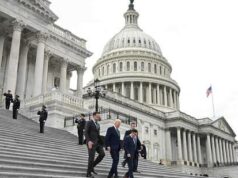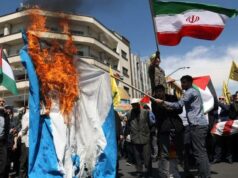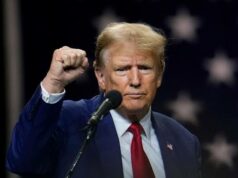Mike Pompeo On The Two Largest Democracies Of The World : Makes Sense Provided Every Thing Is Followed In Letter And Spirit
We Indians agree on what you say. However your President, your Senate, your Congress and your Administration must bear in mind the Cardinal points …..never threaten India, neither with Your Sanctions or your laws or your Fleets or Forces. Also do not try to impose your norms on us. We are no camp followers and have our own free will on everything including …buying of weapons or oil or trading or self defence etc etc. So if you all keep the above in mind then there should be no problem between the largest democracy by geography and the largest democracy by population.
Now one may read what Mike Pompeo has to say :
Just a few weeks ago, a truly historic election — 600 million Indians voted in the largest exercise of the franchise in history. And they gave Prime Minister Narendra Modi a huge mandate. Not since 1971 has an Indian prime minister been returned to office with a single-party majority, and — to borrow a phrase — he enjoyed an awful lot of winning.
Many observers were surprised by the result, but, frankly, I wasn’t. I’ve been watching closely. My team at the State Department is watching closely. And we knew — that the prime minister was a new kind of leader for the world’s most populous democracy. He is the son of a tea seller who worked his way up to governing a state for 13 years and now leads one of the world’s truly emerging powers.
He’s made economic development for the poorest Indians a priority. And indeed, millions who once went without light bulbs now have electricity. And millions who lacked cookstoves now have them.
It’s interesting — that young Indians constituted one of the prime minister’s largest voting blocks, one of his biggest groups of support in this most recent election. I think that tells you something. I think it tells you something that Indian voters think PMModi can and will open up a new, more prosperous future for each of them.
For my part, as the Secretary of State, I know I have a strong partner, a new, great counterpart in Minister Jaishankar — a former ambassador to the United States that most in this room know so well. He said back in April in remarks — he’s ready to cultivate a warmer relationship with America — and he knows that the feeling is mutual. We want to move ahead.
Here’s how we’re thinking about it.
First, we have to build ever-stronger relationships. One of the great things about this gathering, we have a long bond with India. We’ve sent some of our finest minds to New Delhi, thinkers like Daniel Patrick Moynihan and our current ambassador, Ken Juster. But forging stronger ties is more than that. It means formalising these individual friendships, building out a diplomatic framework for our two countries. I think we’ve done that, but there’s more to do. Last year, we kicked off a 2+2 dialogue and I went to attend it alongside the Secretary of Defense.
We also reinvigorated the Quad Dialogue among the United States, Japan, and Australia — all like-minded democracies in the Indo-Pacific. I’m looking forward to my meetings in Delhi next week — and of course, to the tea. We must embrace that strategic framework that I — that works for both of our nations. We respect India as a truly sovereign, important country, with its own unique politics and its own unique strategic challenges.
We get it. We realise it’s different to deal with the likes of China and Pakistan from across the ocean than it is when they are on your borders. That’s why in this room, not so many months ago, I elaborated on President Donald Trump’s vision for a Free and Open Indo-Pacific. It starts from the premise that we share a common set of values — the values of democracy and freedom and a core belief in the ingenuity of the human spirit.
We also have to make sure that we have economic openness. We have to have a central theme being the idea that we have liberty and sovereignty in each of our two nations, and build on those ideas. These need to be places in which economic growth reinforces our democratic values, and not dictatorship. Based on my conversations in New Delhi last year, and in subsequent phone calls and meetings, I believe this is a deeply shared vision.
Third, we have to deliver. We have to execute. The Trump administration has already enabled American companies to export more high-tech items to India. This includes cutting-edge defence platforms like armed UAVs and ballistic missile defense systems. We’ve already launched the Asia-EDGE program, to which Meg referred, to help India raise private capital to meet its energy and security needs for years to come.
These are solid achievements, but we want to do so much more. On defence, the first patch — or excuse me, the first batch of Apache helicopters are coming off Boeing’s production line in Arizona even as we speak. Lockheed Martin’s F-21 and Boeing’s F/A-18 are state-of-the-art fighters that could give India the capabilities it needs to become a full-fledged security provider throughout the Indo-Pacific.
On energy, we want to complete the Westinghouse civil nuclear project, and deliver more LNG and crude. These steps will give Indians reliable, affordable, diversified energy independence so they will no longer have to rely on difficult regimes like those in Venezuela and in Iran.
On space, NASA is already working with the Indian Space Research Organization on the world’s most advanced earth-observation satellite and India’s second lunar mission.
Now, I’m sure we’ll broach some tough topics too. But as we democracies have come to know, that we work out our disagreements. And we’ll probably discuss the recent decision on the GSP program. I do hope, and remain open to dialogue, and hope that our friends in India will drop their trade barriers and trust in the competitiveness of their own companies, their own businesses, their own people, and private sector companies.
I can’t go into everything we’ll discuss here. But suffice it to say this is a deeply important relationship, and I know that these conversations will finally fulfill the great promise of cooperation that was present at India’s birth and which remains evident today.
As Prime Minister Modi said in his latest campaign – he said, “Modi Hai to Mumkin Hai,” “Modi makes it possible.”



